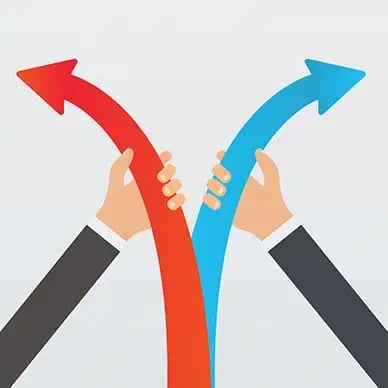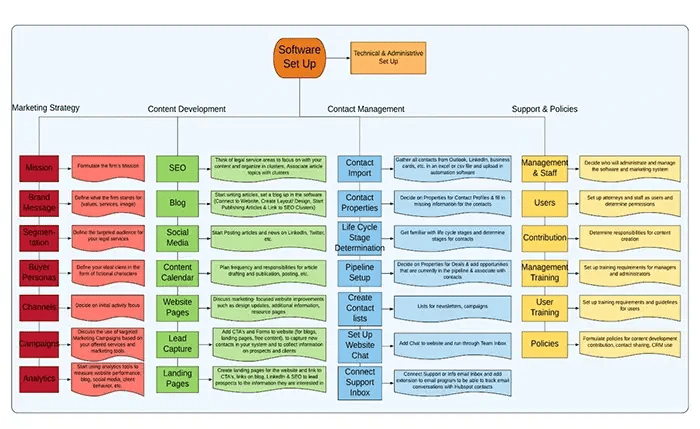
We discuss 3 phases involved in adopting a functional marketing system in our previous post. These 3 phases include: STRATEGY, TACTICS, and AUTOMATION. This post will focus on the 2 approaches we consider to be most effective for the process of marketing system adoption:
1. Linear Approach:
The linear approach follows the path described in our 3 Phases of Law Firm Marketing System Implementation article. First, the STRATEGY is developed including individual and firm marketing and support plan, followed by the TACTICS (budget, activity and contact management). Lastly, an AUTOMATION application is implemented, bringing the firm’s marketing system to the next level.2. Automation Driven Approach:
This is the reverse approach. Instead of developing the system on paper first, the firm starts with the implementation of marketing automation software. Using a “learning-by-doing” approach, the firm develops its strategy and tactics while on-boarding the software. Capable software, like Hubspot, actively promotes the development of strategic and tactical plans along with its software functionalities.
1. Linear Approach
The linear approach is a more traditional process (STRATEGY >> TACTICS >> AUTOMATION) and is ideal for firms that are not as flexible with their current business processes and responsibility redistribution. Firms with little marketing experience and with automation software will find it easier to follow this approach in building their marketing system from the ground up. Incorporating a detailed marketing plan ahead of its implementation, it is certainly a less risky approach.
This approach is also more fitting for firms that rely on relationship-building activities such as networking, organizational involvement, etc. for business development. These firms can start with a simple contact management system to support their marketing activities, rather than creating an automated inbound marketing system that requires regular content development.
2. Automation Driven Approach
In our article “Can software function as your law firm’s next marketing director?” we explained how automation systems ultimately inform a firm’s marketing plan and its support system once they are up and running. Therefore, some firms will find it easier to start with the automation implementation and build the strategy and tactics along the way. This approach is useful for firms who want their marketing system to be driven by an online strategy that informs content development as well as relationship-building activities.
Software (such as Hubspot) provides significant training and education to guide law firms through the technical setup, as well as strategy and tactics development. Hence, firms can build their marketing plan following the implementation of the software, which would immediately start to act as virtual marketing director.
While this sounds fairly simple, it is critical to understand that the software should not be purchased without any plan in place. Before considering automation software, firms needs to develop plans for the needed support and the policies that will guide the the implementation and facilitation of the software.
A few important considerations with this approach:
- Before the implementation of any software, a firm should determine the responsibilities for the on-boarding and for holding administrators and contributors accountable.
- The first 3-6 months are most critical to learn and understand the software's functions, develop the strategy and tactics, and frequently use the tools of the software. This initial time will develop the rhythm of the software for the future.
- Consistency is key. Administrators and attorneys need to be frequent users of the software to become proficient with the tools. Attorneys must develop a habit of using the software’s tools during time set aside for business development.
Firms that prefer to take the Automation Driven Approach and implement marketing automation software before developing the firm and individual attorney marketing plans should consider the steps displayed in the following graphic when setting up the software:

The steps in the graphic above include the major tasks involved in the on-boarding phase of a marketing automation software including the technical setup, the development of a marketing strategy, content creation and delivery, contact management and a support system.
Once the technical on-boarding phase concludes after three months, the firm and its individual attorneys can begin to develop their own marketing strategies and tactics. Plans can include marketing activities such as blogging and email newsletter distribution that the marketing software can help them to implement. Then, using the data the marketing software captures, the firm and its attorneys can continue to enhance the software's content development and contact management functions. As the firm becomes more proficient in utilizing the software, it can more precisely determine its budgets for all marketing activities.
Before adopting a marketing system, law firms must consider their marketing needs and priorities to determine the best approach to take. If a marketing system is implemented with careful focus and care, a law firm can attain the benefits of an effective automation system.
More than a marketing support tool, a marketing automation application can become the driving force behind all marketing-related activities that a firm and its attorneys engage in.
.webp?width=124&height=108&name=PerformLaw_Logo_Experts3%20(1).webp)


